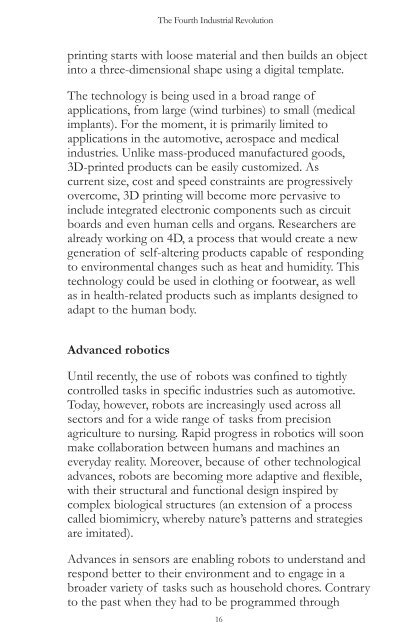The Fourth Industrial Revolution
WEF_The_Fourth_Industrial_Revolution
WEF_The_Fourth_Industrial_Revolution
You also want an ePaper? Increase the reach of your titles
YUMPU automatically turns print PDFs into web optimized ePapers that Google loves.
<strong>The</strong> <strong>Fourth</strong> <strong>Industrial</strong> <strong>Revolution</strong><br />
printing starts with loose material and then builds an object<br />
into a three-dimensional shape using a digital template.<br />
<strong>The</strong> technology is being used in a broad range of<br />
applications, from large (wind turbines) to small (medical<br />
implants). For the moment, it is primarily limited to<br />
applications in the automotive, aerospace and medical<br />
industries. Unlike mass-produced manufactured goods,<br />
3D-printed products can be easily customized. As<br />
current size, cost and speed constraints are progressively<br />
overcome, 3D printing will become more pervasive to<br />
include integrated electronic components such as circuit<br />
boards and even human cells and organs. Researchers are<br />
already working on 4D, a process that would create a new<br />
generation of self-altering products capable of responding<br />
to environmental changes such as heat and humidity. This<br />
technology could be used in clothing or footwear, as well<br />
as in health-related products such as implants designed to<br />
adapt to the human body.<br />
Advanced robotics<br />
Until recently, the use of robots was confined to tightly<br />
controlled tasks in specific industries such as automotive.<br />
Today, however, robots are increasingly used across all<br />
sectors and for a wide range of tasks from precision<br />
agriculture to nursing. Rapid progress in robotics will soon<br />
make collaboration between humans and machines an<br />
everyday reality. Moreover, because of other technological<br />
advances, robots are becoming more adaptive and flexible,<br />
with their structural and functional design inspired by<br />
complex biological structures (an extension of a process<br />
called biomimicry, whereby nature’s patterns and strategies<br />
are imitated).<br />
Advances in sensors are enabling robots to understand and<br />
respond better to their environment and to engage in a<br />
broader variety of tasks such as household chores. Contrary<br />
to the past when they had to be programmed through<br />
16


